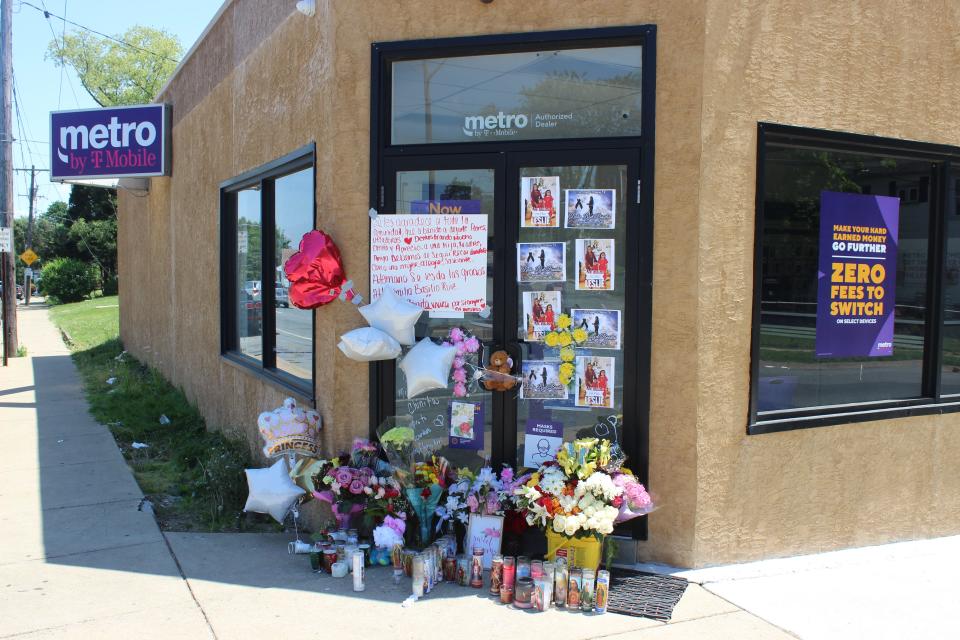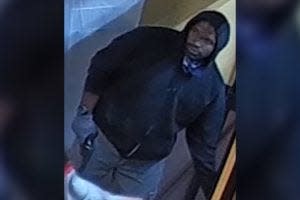Jury begins deliberation in case of man accused of multiple murders in Delaware and Philly
A jury will soon begin deliberations in the case of a man accused of killing two, shooting another and robbing another in a spring 2021 crime spree in Wilmington.
Keith Gibson faces charges including two counts of first-degree murder and attempted murder for the killings of 28-year-old Leslie Ruiz-Basilio at an Elsmere cell phone store in May 2021 and Ronald Wright, 42, at a residence in Wilmington the following month. He is also accused of shooting a convenience-store clerk in Wilmington and robbing a city Rite Aid around the same time.
Law enforcement in Philadelphia have said that once proceedings in Delaware are complete, they will charge him with four additional murders that occurred in that city around the same time.
During closing summations to the jury on Monday, prosecutors emphasized the similarities in each of the Delaware crimes and a series of "puzzle pieces" they say link Gibson to them as well as one of the Philadelphia murders. Each featured a black man, his face at least partially concealed, wearing gloves, holding a revolver in his right hand, holstering it to his left and robbing businesses, prosecutors said.
His defense attorney honed in on puzzle pieces she said were missing from the state's case, which she said boiled down to: "If we can’t prove (the crimes) individually, let's just tell you they are all similar."
What happened at the cell phone store?
The most clear-cut link between Gibson and the cell phone store murder is the discovery by a neighbor of a blue bike, which Deputy Attorney General John Downs reminded the jury was found in the woods a five-minute walk from the store on the same day as the murder.
The bike would later be linked to Gibson with its serial number, a receipt found in his Philadelphia residence, as well as a key to the lock on the bike that was recovered from his keyring when he was arrested.
A single witness was able to identify Gibson from video showing the crime. She was a former associate of Gibson's who said she could identify him in that video and in video of some of the other accused crimes from his appearance and movements.

She told the jury that Gibson told her he had lost the bike doing a "lick," which she said she later learned meant a robbery. Megan Davies, Gibson's defense attorney, questioned the woman's credibility. She said that Gibson allegedly told the woman that in a text message, but no text message was presented to the jury.
The woman contacted the police and identified Gibson after seeing a photo of the killer in a Philadelphia murder on social media. Davies suggested that she might have been biased toward identifying Gibson in video from the cell phone store when police showed it to her later on after she had identified him in the Philadelphia murder.
Basilio's killer also stole her car and police would later locate it in Philadelphia "walking distance" from where Gibson was living, Downs said.
They also found a person using one of the cell phones stolen that day. An associate told the jury he had bought it from someone on the street. Detectives later discovered Keith Gibson's number and nickname in the phone.
The man did not testify about how that number got in there or where he got the phone. Other stolen phones were also not recovered, which Davies characterized as another missing puzzle piece.
Who killed Ronald Wright?
Prosecutors again leaned on the identification made by Gibson's former associate in videos that depict a person entering the building where Wright was murdered.
In defense, Davies asked the jury why prosecutors did not call to the stand witnesses who were standing outside the building before the murder occurred as well as other people who were in that immediate area that night.
Prosecutors also touched on the testimony of Wright's sister.
She told the jury that her brother always carried a black sling bag with him. When Gibson was arrested, he was wearing such a bag. In court, prosecutors showed Wright's sister the bag they recovered from Gibson and, she told the jury it was her brother's.
Prosecutors also emphasized evidence from a detective who surmised that Wright likely had been shot by a revolver since no shell casing was recovered from the murder scene.
The Good Guys Deli
Gibson's former associate also identified him in video of the robbery of a convenience store in Wilmington. In that case, the clerk was shot at, and fell to the floor before the perpetrator began to rummage through the cash register. While doing that, he shoots the clerk on the floor twice. The clerk would survive and testified during the trial.
Prosecutors also noted that video of the robbery showed the man holstering his revolver on his left side. Gibson would later be arrested wearing a belt with a left-sided holster. They also pointed to gloves depicted in the video that bear similarities to ones found in his residence.
Previous reporting: How a man wanted in 3 recent killings in Philadelphia, Delaware was out on the street
They also leaned on testimony from a woman who said she saw Gibson shortly before the shooting. She was sitting in front of her house near the convenience store smoking marijuana with others when she noticed an unfamiliar person standing across the street fidgeting with his pants.
She said the man walked in the direction of the store and she later heard the calamity that followed the shooting and robbery. In court, she identified for the jury the stranger as Gibson.
Davies noted to the jury that the woman had admitted she had been smoking marijuana and asked them to consider why no others who she said were there testified at the trial.
Rite Aid arrest
Police arrested Gibson shortly after the robbery of a Rite Aid in Wilmington's Adam's Four area. Downs, the prosecutor, said this crime was an "outlier" because it was carried out by two individuals and the victim was not shot.
He centered on the revolver, the efforts of the robber to conceal their identity and other similarities in clothing between the crimes.
The clerk in that store gave the robbers cash outfitted with a tracking device which led police to Gibson hiding in a backyard nearby. Near his hiding place, police found a black revolver.

He was wearing a bulletproof vest, was armed with a knife and an empty gun holster, and carried gloves, a mask, bullets and cash in his pockets, prosecutors said.
Police would find cash, cigarettes and clothes prosecutors said matched the Rite Aid robbery in a house nearby. Davies noted they never found the tracker or the white bag the robbers carried from the scene, asking where they would be if not with the true perpetrator.
No DNA link
Much of the closing arguments on both sides focused on police forensic experts' comparisons of bullets found on Gibson when he was arrested, in the revolver recovered near him and in the murder victims.
In some cases, the bullets were similar types, types which prosecutors characterized as "rare." In some cases, experts could say that the bullets had been fired by a similar weapon.
Davis emphasized to the jury testimony of the "subjective" nature of such comparisons. She also asked the jury to consider the lack of any DNA evidence linking her client to the crime.
Opening statements: Police say he killed people in Wilmington and Philadelphia. What first day of trial showed
"Missing puzzle pieces, questions the state did not answer: they amount to reasonable doubt," Davies told the jury.
Downs, the prosecutor, told the jury that it is normal that DNA isn't always present on pieces of evidence. He noted that detectives could only find one DNA link for Basilio to her own car during the course of the investigation.
He characterized the perpetrator as careful to cover his steps and implored the jury to consider the breadth of evidence they presented.
"All those puzzle pieces, when you are in that jury room, you bring them together and you get a picture of who committed these crimes, a clear picture," Downs said.
Contact Xerxes Wilson at (302) 324-2787 or xwilson@delawareonline.com.
This article originally appeared on Delaware News Journal: Jury begins deliberation in Keith Gibson murder trial in Delaware

